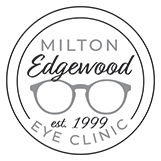Age-related Macular Degeneration (AMD)
Slow the progression of this silent thief of sight.
Age-related macular degeneration (AMD) is the leading cause of blindness in men and women over age 50.
Even though AMD is common among older people, it’s not as well known as cataracts — another eye disease that occurs more often with age. But while cataracts can be treated and “cured,” there’s no cure for AMD. Instead, people who have AMD require treatments that help slow the progression of the disease, which is why early detection is very important.
If you are concerned about macular degeneration, call Milton-Edgewood Eye Clinic or schedule your appointment online.
What is age-related macular degeneration?
Age-related macular degeneration — abbreviated as AMD — is a disease of the retina, the light-sensitive portion of your eye. The retina is located at the back of the eye, and the macula is a small area near the very center. Your macula is responsible for your central vision.
In AMD, the macula loses its ability to detect light, resulting in a partial or total loss of central vision. People with late-stage AMD are unable to see objects straight in front of them, making it difficult to perform many activities, like using a computer, reading, driving, or recognizing faces.
AMD typically causes no symptoms until vision begins to fade. Having routine eye exams, especially over age 50, is important for catching AMD as early as possible.
What are the risk factors for AMD?
Age is the biggest risk factor for AMD, followed by having a family history of AMD. You’re also at greater risk of developing AMD if you are:
- Caucasian (white)
- Female
- Have had prolonged sun exposure
- A smoker or past smoker
- Genetic predisposition
Can I reduce my risks of developing AMD?
One of the most important things you can do is have regular eye exams to monitor the health of your retinas.
Taking specific “eye vitamins” may help slow the progression of AMD, and it’s also important to take care of your overall health. Quitting smoking, exercising regularly, maintaining a healthy weight, and controlling your blood pressure and your cholesterol are important lifestyle changes you should consider.
You should also wear sunglasses that protect you from UVA and UVB rays and use blue light protection when operating a computer or your cell phone.
How is AMD treated?
AMD occurs in different stages, and there are two types of AMD: dry and wet. The dry type is much more common, but the wet type is more severe and also develops more quickly.
If you have the wet form of AMD, medications or laser therapy may help slow your vision loss. Otherwise, treatment focuses on monitoring the progression of the disease, along with taking nutritional supplements and incorporating the lifestyle changes listed above.
How is AMD detected?
Dilated eye exams allow your eye doctor to look at your retina so they can check for changes associated with AMD, and until recently, those exams were the only tool eye doctors had to detect this disease.
Today, there are more advanced computer-based options that enable your eye doctor to identify the very earliest signs of AMD. At Milton-Edgewood Eye Clinic, we offer the following for diagnosis:
AdaptDx®
Difficulty seeing in the dark or in low-light environments is one of the earliest signs of AMD. The AdaptDx® dark adaptometer measures how long it takes for your eyes to adjust to darkened environments. The test takes just 10 minutes to complete, and in many cases, the cost can be billed to your insurance provider. If you’re having difficulty seeing in the dark, ask your eye doctor if the AdaptDx® test is right for you.
Optomap®
Optomap® uses special scanning technology to capture a detailed image of your retina. With Optomap® technology, your eye doctor can see as much of the retina as possible, including the peripheral areas where the first signs of AMD are most likely to occur. Plus, Optomap® provides cross-sectional images of the important structures of your retina, making it possible for your doctor to see the subtlest, earliest changes associated with AMD. The scan takes less than a second, and it’s completely noninvasive.
At Milton-Edgewood Eye Clinic, we want all our patients to enjoy the best possible vision at every age. To learn more about AMD screening in Milton or to schedule an eye exam, give us a call or book your appointment online.



